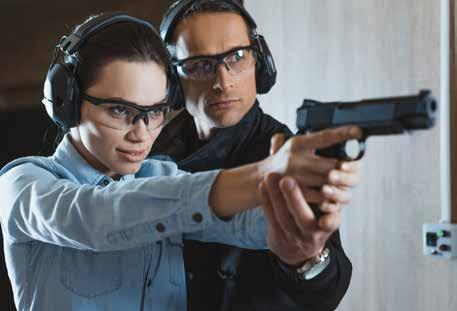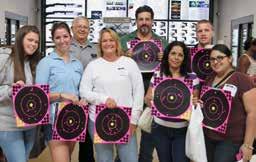
10 minute read
The Elusive Stress Fracture in the Runner
T H E E L U S I V E Stress Fracture in the Runner
By Dr Michael M Cohen DPM FACFAS
Advertisement
Nothing is more frustrating to a runner than an injury which occurs just when the training schedule calls for ramping up mileage or intensity in time for competition. Over my 35 years as a foot and ankle specialist treating runners in our community, I have personally witnessed not just the physical, but emotional toll these injuries can inflict. I can truly empathize with them as I myself have fallen victim to these same unfortunate circumstances and on multiple occasions. As runners, we forget that our sport is not a passive but violent one, as each foot strike results in an impact equivalent to 3 or 4 times our body weight. To put it bluntly, training is a form of self-inflicted injury with the hopes that the ongoing cycle of injury and healing will ultimately lead to stronger muscles, tendons, and bones after recovery. This is a positive and most desirable outcome we refer to as “conditioning”. Unfortunately, training exuberance tips the balance in favor of injury, sometimes with the best intentions of the coach or athlete and leads to the body’s inability to regenerate or strengthen properly. This is when breakdown (injury) occurs resulting in a concept I call “reverse conditioning” secondary to overtraining.
One such common running injury is referred to as a stress reaction which in later stages develops into a stress fracture. Most athletes with a stress reaction present with an insidious onset of pain in a focal area sometimes confused with muscle soreness or tendinitis. Stress reactions and stress fractures represent fatigue failure injuries and are secondary to overuse. A stress reaction precedes a stress fracture in the bone fatigue continuum and is hallmarked by microscopic failure without an actual visible break in the bone. X-rays are typically negative in this stage of injury and better imaged with bone scans or MRI. The MRI is a very sensitive imaging technique which depicts swelling in bone at this early stage. As the fracture continues to develop, heat, swelling and pain are noticed during everyday activities. In severe cases, the pain eventually precludes comfortable weight-bearing and physical exercise causing the athlete to limp.
Stress on bone creates constant remodeling affecting a balance between the cells which eliminate injured bone (like a tiny vacuum cleaner) and cells which replace injured bone with newer healthier bone. Overtraining, either by adding mileage, speed or inclines will tilt the balance in favor of the cells evacuating injured bone. This ultimately results in a negative balance of healthy bone cells progressing to stress injury. Adding insult to injury, weak muscles in the thigh and leg supporting the bone structure by absorbing shock may further stress the physiologic capacity of bone to maintain its integrity causing it to fatigue. This is not unlike bending a paper clip back and forth until heat develops causing the metal wire to fatigue until it snaps into two segments. Stress fractures are very similar as the continued stress of training results in fatigue failure of bone, leading to microscopic cracks and subsequent true fracture if allowed to continue. It is during these late stages of the process that X-rays become a more reliable tool.
Not all stress fractures are the same
Stress fractures are generally classified into two types: low-risk fractures- those that heal well and usually without long term sequela and high-risk fractures - those which do not heal well and often require surgery. The designation of these two classification systems is essentially based on the location of these fractures. Bone stress injury treatment and return to play decision making is based on the site of injury, potential for healing, and risk of significant complication. Proper treatment of the fracture is essential to avoid under or over-treating the condition. Clearly over-treating the fracture may result in an unnecessary disruption of training and subsequent loss of physical conditioning referred to as “deconditioning”. Stress fractures deemed as high risk poses a significant risk for recurrence due to inadequate healing and at times may result in potentially devastating complications leading to career ending injuries. Prompt diagnosis and treatment is fundamental in allowing proper healing thereby minimizing the impact of the injury.
Treatment
Treatment for stress fractures should not focus on boney healing but should include an investigation of what we refer to as the intrinsic and extrinsic causes which resulted in the injury in the first place. Intrinsic factors include 1. Biomechanical- body type, foot type, inherent weakness and flexibility, and a factor many gloss over- running technique, 2. Nutritional specifically insufficient intake of protein, calcium, and vitamin D 3. Hormonal factors- the most notable of which is estrogen. Female athletes with low bone mass have a higher predilection for certain stress fractures. This is especially noted in women at risk. This includes those with low body mass, or have stopped menstruating and/ or have a history or family history of osteoporosis. This group will require a proper medical workup consisting of blood tests and a bone density scan often requiring a team approach with various specialists.
Extrinsic factors on the other hand consist of training errors and improper equipment. This includes but is not limited to the influences of terrain, running form, and improper running shoes. To be effective, an individualized developmental plan for an effective return to play schedule should take these factors into consideration. The strategy, particularly when dealing with low-risk fractures, may require decreasing training volume and intensity, using proper equipment, changing running technique, and cross-training. Using this tactic assures that the athlete does not suffer a substantial loss of conditioning while recovering from injury. Sports medicine physicians realize all too well that extended time off training may adversely affect the recovery. Recouping the body’s strength, flexibility, and ability to balance is significantly hindered with overprotective measures and results in an extended loss of training time. So why create a problem in order to solve one? With a proper rehabilitation plan, the athlete is given the best chance for a faster recovery while resulting in a protective effect from future injury.
Alternatively, high-risk stress fractures as previously mentioned have more frequent complications such as poor healing, non-healing, and at times re-fracturing after healing is thought to have been completed. These are very frustrating scenarios which unfortunately often leads the athlete to abandon the sport. The treatment for high-risk stress fractures should be based on the immediate goal of preventing any progression of the fracture and avoiding long-term complications. Because of the significant complications associated with this injury, it is suggested that athletes with evidence of a high-risk stress fracture immediately discontinue their activity. Unfortunately, with these fractures, prolonged immobilization with weight-bearing restrictions or operative management are often the treatments of choice.
So, remember to listen to those nagging injuries and avoid reverse conditioning. Make sure that you heed the signs of injury before the injury heeds you.
heel pain in a runner thought to be plantar fasciitis but MRI reveals a stress fracture of the heel
⊲ Dr. Cohen is a published author, is on faculty at several South Florida residency programs, podiatric medical colleges, and frequent lecturer. He is a former runner with a marathon PR of 2:37 at age 21; 2:50 at age 39 and at 50 was a top 3 age group finisher in both the ING Miami and Disney Half Marathons.
He practices with the Foot, Ankle and Leg
Specialists of South Florida specializing in lower leg injuries and reconstructive surgery of the foot and ankle. The practice includes
Robert Sheinberg DPM, Al DeSimone MD,
Fernando Moya MD PhD, Alexander Bertot
MD, David Shenassa MD, Carlo Messina DPM,
Franz Jones DO and John Goodner DPM.
The South Florida Institute of Sports Medicine in Weston is located at 1600 Town Center
Blvd., Suite C, (954) 389-5900 and in
Pembroke Pines at 17842 NW 2nd Street, (954) 430-9901 The practice website is www. southfloridasportsmedicine.com
ACCEPTING: MEDICARE •BLUE CROSS BLUE SHIELD • UHC • CIGNA • AETNA • AV MED • AMBETTER • TRICARE WORKERS COMP • ACCIDENTS/LOPS • SIMPLY • STAYWELL • SUNSHINE • BETTER HEALTH • OSCAR • MEMORIAL PHO
South Florida Institute of Sports Medicine
FOOT, ANKLE, & LEG SPECIALISTS OF SOUTH FLORIDA
OPEN DAILY FOR SAME DAY APPOINTMENTS & TELEMEDICINE DURING THE COVID19 CRISIS
PEDIATRICS
• Flat feet • Toe Walkers • High Arches • In Toe • Fractures • Out Toe • Growing Pains • Limping • Warts • Ingrown Nail
FRACTURES
Why go to an Emergency Room? All Foot, Ankle, and Leg Fractures in Children and Adults!
FOOT AND ANKLE ARTHRITIS
Total Joint Replacement, Ankle Replacement, Arthroscopy, Fusions, Joint Realignment
CARTILAGE INJURIES
Microfractures, Cartilage Transplants, Osteochondral Grafting
RECONSTRUCTIVE FOOT, ANKLE AND LEG SURGERY
Flat Foot, Bunions, Hammertoes, Ligament Repair, Achilles Tendon Tears, Arthritis Surgery
SPORTS MEDICINE
Tendon and Ligament injuries, Heel Pain, Shockwave Therapy, PRP & Stem Cell Injections, Arthroscopy and Tendoscopy, Shin Splints, Compartment Syndrome
SERVING OUR PATIENTS FOR OVER 30 YEARS
Dr. Warren Windram, D.P.M.
Board Qualified FOOT, ANKLE, & LEG SPECIALIST Dr. John Goodner, D.P.M.
Board Qualified FOOT, ANKLE, & LEG SPECIALIST Dr. Robert Sheinberg, D.P.M.
- In Loving Memory Dr. Carlo Messina, D.P.M.
Board Certified FOOT, ANKLE, & LEG SPECIALIST Dr. Michael Cohen, D.P.M.
Board Certified FOOT, ANKLE, & LEG SPECIALIST
WESTON
1600 Town Center Blvd.
954-389-5900 PEMBROKE PINES
17842 NW 2nd St.
954-430-9901 PLANTATION
220 S.W. 84th Ave., #102 954-720-1530
SATURDAY HOURS Make Your Appointment Online at www.SouthFloridaSportsMedicine.com
FOOT, ANKLE & LEG QUESTIONS? EMAIL THE DOCTOR! DrJohnGoodner@gmail.com (Don’t Send Protected Health Information)
IMEs • Personal Injury • Worker’s Compensation Most HMOs/PPOs • All Foot Ankle & Leg Emergencies Same Day Appointments • Saturday Appointments Early Morning & Evening Appointments
New Patient . . . . . . . . . . . . . . $200 Follow Up Visit . . . . . . . . $50-$100 PRP . . . . . . . . . . . . . . . . . . . . . $600
SELF PAY RATES (Procedure cost is in addition to office visit.) Surgery Consult . . . . . . . . . . . $200 Orthotics . . . . . . . . . . . . . . . . . $350 Shockwave (3 sessions) . . . . $500
(FOR CHRONIC HEEL PAIN & TENDONITIS) Injections . . . . . . . . . .$75 per shot Ingrown Nail . . . . . . . . . . . . . .$125 Laceration Repair . . . . . . . . . $250 Casts . . . . . . . . . . . . . . . . . . . . .$175 X-Rays . . . . . . . . . . . . $50 per area Wound Care . . . . . . . . . . .$75-$125
Dr. Al DeSimone, M.D.
Board Certified SHOULDER & KNEE SPECIALIST SPORTS MEDICINE ASSOCIATES (Self Pay Rates Do Not Apply To This Practice Below) Dr. Fernando Moya, M.D.
Board Certified SHOULDER & KNEE SPECIALIST Dr. David Shenassa, M.D.
Board Qualified HAND & WRIST SURGEON Dr. Alexander Bertot, M.D.
Board Certified SPORTS MEDICINE SPECIALIST Dr. Franz Jones, D.O.
Board Certified SPINE SPECIALIST

LEARN FROM THE PROS
> The ONLY 5-STAR range in all of South Florida > Featuring the NEXUS LANES live-fire computerized targets. Shoot your gun and ammo at moving targets, shooting galleries, videos and more. > First time shooter, female, and family FRIENDLY. > COOL and CLEAN air-conditioned range. > Thousands of firearms, ammo, accessories, and RENTAL guns. > LADIES DAY: Every Monday ladies get FREE range time.
2020
FREE CLASSES FOR MEMBERS

YOUTH SAFETY CLASS
Teaches minors the ins and outs of gun safety and basic marksmanship. Sign up at www.NexusShooting.com
FIREARM LAW SEMINARS
Learn when you can legally use your gun and how to protect yourself from liability. Sign up for our email list to receive class schedule, www.NexusShooting.com

954-587-8005 • 2600 Davie Road, Davie, FL 33314 www.NexusShooting.com
$5
LIFETIME MEMBERSHIP
Coupon Required. Good for up to 4 people. Cannot be combined w/other offers. Expires 3/31/21. Please see website for rental & range restrictions. No gun rentals by solitary shooters. www.NexusShooting.com • OC5LM
$10 OFF
CONCEALED WEAPONS PERMIT CLASS
Coupon Required. Good for up to 4 people. Cannot be combined w/other offers. Expires 3/31/21. Please see website for rental & range restrictions. www.NexusShooting.com • OCCWP10OFF





